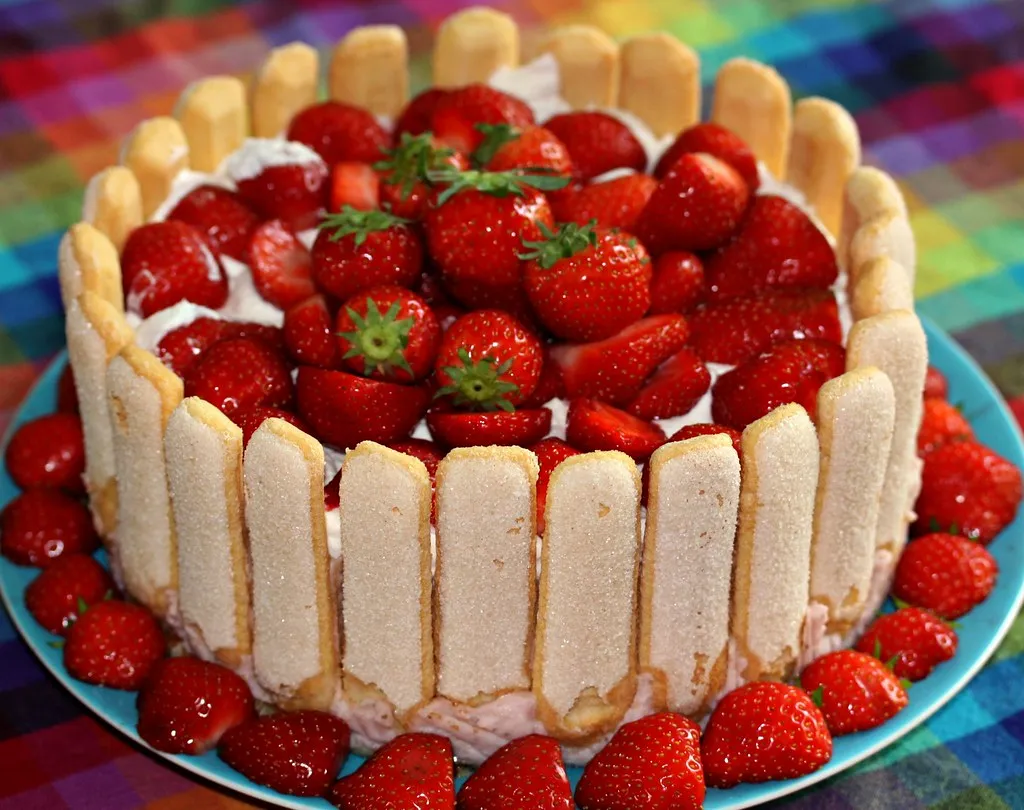The Best Fluffy Pancakes recipe you will fall in love with. Full of tips and tricks to help you make the best pancakes.
Strawberry Charlotte Cake is a stunning French dessert that’s both elegant and delicious. It features soft ladyfingers, airy strawberry mousse, and a light whipped cream topping. This refreshing, no-bake treat is perfect for special occasions or simple indulgence.
This guide covers everything you need to make the perfect Strawberry Charlotte Cake. From choosing the right ingredients to troubleshooting mistakes, you’ll learn how to achieve a flawless texture, balanced sweetness, and a beautiful presentation. Impress your guests with a dessert that looks straight out of a French pâtisserie!
Understanding the Charm of Strawberry Charlotte Cake
Strawberry Charlotte Cake is a timeless French classic, combining elegance, simplicity, and rich flavors. With its light texture and delicate taste, this beautifully crafted dessert remains a favorite among bakers and pastry lovers alike. But what makes this dessert so special? Let’s explore its history, unique characteristics, and how it compares to similar treats.

A Brief History of Charlotte Desserts
Charlotte Cake dates back to the 18th century and is believed to be named after Queen Charlotte, wife of King George III of England.. Originally, it was a baked dessert made with bread, custard, and fruit. French pastry chef Marie-Antoine Carême transformed the Charlotte Cake into Charlotte Russe, a no-bake version that swapped bread for ladyfingers and featured a Bavarian cream or mousse filling. This transformation resulted in a light, airy, and refreshing dessert.
Strawberry Charlotte Cake is a delightful variation, featuring a creamy strawberry mousse and fresh berries, encased in a delicate border of ladyfingers or sponge cake. Often enjoyed in spring and summer when strawberries are at their peak, it’s a favorite for warm-weather celebrations.
What Makes a Strawberry Charlotte Cake Unique?
Unlike traditional cakes that rely on baked sponge layers, the Charlotte Cake is structured using ladyfingers—delicate, airy biscuits that absorb moisture from the filling, creating a soft yet stable foundation. Here are a few reasons why this cake stands out:
- No-Bake Elegance – Unlike most cakes that require baking, this dessert is assembled and chilled, making it a perfect make-ahead dessert for special occasions.
- Light and Airy Texture – The combination of whipped cream, strawberry purée, and gelatin creates a mousse-like consistency that’s refreshing rather than heavy.
- Beautiful Presentation – With its classic crown of ladyfingers and vibrant strawberry topping, this cake is as visually stunning as it is delicious.
- Customizable Flavors – While strawberries are a classic choice, Charlotte Cakes can also be made with raspberries, mango, chocolate, or even coffee-infused mousse.
How It Compares to Similar No-Bake Desserts
Many people confuse Strawberry Charlotte Cake with other no-bake, mousse-based desserts, but it has some distinct differences:
- Tiramisu – Tiramisu also uses ladyfingers, but they are soaked in espresso and layered with mascarpone cheese, giving it a rich, coffee-flavored profile rather than a fruity freshness.
- Cheesecake – Unlike cheesecakes, which have a denser texture due to cream cheese, Charlotte Cakes are lighter and more mousse-like.
- Mousse Cakes – Mousse cakes rely on a sponge or cookie base, while Charlotte Cakes use ladyfingers as both the base and the outer structure.
Why You Should Try Making a Strawberry Charlotte Cake
If you’re looking for a dessert that’s easy to make, visually stunning, and bursting with fresh strawberry flavor, a homemade Strawberry Charlotte Cake is the perfect choice. It’s a refreshing alternative to heavier cakes, making it ideal for spring and summer celebrations. Plus, with its simple yet sophisticated construction, you can impress your guests with a professional-looking dessert without spending hours in the kitchen.
In the next section, we’ll go over the essential ingredients you’ll need to create the perfect Strawberry Charlotte Cake from scratch.
Key Ingredients and Their Role in a Perfect Charlotte Cake
The Strawberry Charlotte Cake may look elegant and complex, but it relies on a handful of carefully chosen ingredients that work together to create its light, airy texture and refreshing flavor. Understanding the role of each ingredient is key to achieving a perfectly balanced, stable, and delicious dessert. Let’s take a closer look at the essential components of a homemade Strawberry Charlotte Cake and how they contribute to its structure and taste.
1. Ladyfingers (Biscuits à la Cuillère) – The Cake’s Foundation
Ladyfingers, also known as savoiardi biscuits, are the backbone of a Charlotte Cake. These light, airy, and slightly sweet sponge biscuits are used to form both the outer wall and the base of the cake, creating the signature crown-like appearance.
Why They Are Important:
- Absorb Moisture Perfectly – Ladyfingers soak up the moisture from the filling, softening into a cake-like texture without becoming soggy (if prepared correctly).
- Provide Structure – Since Charlotte Cakes are typically no-bake, ladyfingers serve as the “cake layers,” holding everything together while adding a subtle sweetness.
- Create a Beautiful Border – Their classic shape and golden color add to the elegance and charm of the dessert.
Pro Tips:
- Store-bought vs. Homemade: While store-bought ladyfingers work well, making them from scratch allows for better texture control and a fresher taste.
- Dipping Technique: Lightly dip ladyfingers in strawberry syrup or fruit purée for extra flavor—avoid over-soaking, or they will become mushy.
2. Fresh Strawberries – The Star Ingredient
A Strawberry Charlotte Cake wouldn’t be complete without its juicy, naturally sweet strawberries. This fruit is used in multiple components of the cake: the mousse, the syrup for dipping ladyfingers, and as a garnish.
Why They Are Important:
- Provide Natural Sweetness and Acidity – Strawberries balance the richness of the whipped cream with their bright, fresh flavor.
- Add Vibrant Color – Blended strawberries create a beautiful pink hue in the mousse.
- Enhance the Aroma and Freshness – Fresh strawberries used as a topping make the cake visually appealing and fragrant.
Pro Tips:
- Use Fresh, Ripe Strawberries: The best flavor comes from sweet, in-season strawberries. Avoid overripe berries, as they can become too watery.
- Enhance with a Touch of Lemon Juice: A small amount of lemon juice in the purée enhances the natural tartness and prevents browning.
3. Whipped Cream (Crème Chantilly) – The Light and Airy Component
The filling of a Strawberry Charlotte Cake is typically a strawberry mousse, and whipped cream is what gives it its signature light, cloud-like texture.
Why It’s Important:
- Creates a Fluffy and Airy Consistency – Whipped cream ensures the filling remains soft yet stable.
- Balances the Sweetness – Its mild, creamy flavor complements the fruit without overpowering it.
- Adds to the Elegance of the Cake – Used as a garnish, it enhances the visual appeal and makes each bite indulgent.
Pro Tips:
- Use Heavy Cream (at least 35% fat): This ensures a stable whip that holds its shape.
- Stabilize with Gelatin or Cornstarch: This prevents the whipped cream from deflating over time, ensuring a firm mousse.
- Chill Before Whipping: Cold cream whips better and results in a smoother, more voluminous texture.
4. Gelatin or Agar-Agar – The Secret to a Perfectly Set Mousse
A common mistake when making Charlotte Cakes is ending up with a runny or unstable mousse. This is where gelatin (or agar-agar for a vegetarian option) plays a key role.
Why It’s Important:
- Helps the Mousse Hold Its Shape – Without it, the filling may be too soft and won’t slice neatly.
- Adds Stability Without Affecting Texture – A small amount keeps the mousse light and smooth without making it rubbery.
Pro Tips:
- Using Gelatin: Dissolve unflavored gelatin in warm water before adding it to the strawberry mixture to ensure it blends evenly. For a step-by-step guide on how to properly bloom and use gelatin, check out this ChefSteps tutorial.
- Using Agar-Agar: If using a plant-based alternative, adjust the quantity (agar-agar sets firmer than gelatin).
- Avoid Overheating: Adding gelatin or agar-agar to hot liquids can affect their setting ability.
5. Sweeteners and Flavor Enhancers – The Finishing Touches
While strawberries naturally provide sweetness, a well-balanced Charlotte Cake benefits from additional sweeteners and flavor enhancers to bring out the best in its ingredients.
Key Additions:
- Sugar or Honey – Used in the mousse, syrup, and whipped cream to enhance sweetness.
- Vanilla Extract – Adds warmth and depth to the overall flavor.
- Strawberry Syrup or Liqueur – Some recipes include a touch of Grand Marnier or Kirsch for a refined flavor boost.
Pro Tips:
- Adjust Sweetness to Taste: If your strawberries are extra sweet, you may need less sugar.
- Use Pure Vanilla Extract: It provides a more authentic and aromatic flavor compared to artificial versions.
- Alcohol Is Optional: While traditional French recipes may use liqueur, you can substitute it with a simple strawberry syrup for a non-alcoholic version.
Bringing It All Together
Each ingredient in a Strawberry Charlotte Cake has a specific purpose, contributing to the cake’s stability, texture, and overall taste. By using high-quality ingredients and following proper techniques, you can ensure that your homemade Charlotte Cake is light, flavorful, and picture-perfect.
In the next section, we’ll go step by step through the process of making this elegant dessert, from preparing the strawberry mousse to assembling the ladyfingers for a stunning final presentation.
Instructions for Making a Flawless Strawberry Charlotte
Creating a homemade Strawberry Charlotte Cake may seem intricate, but by following a structured approach, you can achieve a beautiful, professional-looking dessert with ease. This section will guide you step by step, from preparing the ingredients to assembling the cake for a flawless finish.
1. Preparing the Ladyfingers Base and Border
1: Choose and Prepare Your Ladyfingers
- If you’re using store-bought ladyfingers, ensure they are firm and dry, as they need to hold up the structure of the cake.
- If you prefer to make them from scratch, bake light, sponge-like ladyfingers and allow them to cool completely before use.
2: Trim and Arrange the Ladyfingers
- Line a 9-inch springform pan or cake ring with parchment paper to prevent sticking.
- Trim the bottom edges of the ladyfingers so they stand upright with a uniform height when placed around the pan. This ensures a neat and elegant border.
- Arrange the ladyfingers vertically along the inner wall of the pan, with their sugared sides facing outward for a polished appearance.
- Place a single layer of ladyfingers on the bottom of the pan, covering the base as evenly as possible.
3: Lightly Soak the Ladyfingers
- To keep the ladyfingers moist yet firm, lightly brush or dip them in a strawberry syrup (made by blending fresh strawberries with a bit of sugar and water).
- Avoid over-soaking, as excessive moisture can cause them to become too soggy and lose their structure.
2. Making the Fresh Strawberry Mousse Filling
1: Prepare the Strawberry Puree
- Wash, hull, and puree fresh strawberries in a blender or food processor until smooth.
- Strain the puree through a fine mesh sieve to remove seeds and ensure a silky texture.
- If the strawberries are slightly tart, mix in a tablespoon of sugar or honey to enhance their natural sweetness.
2: Bloom and Melt the Gelatin
- In a small bowl, sprinkle unflavored gelatin over 2-3 tablespoons of cold water and let it sit for 5-10 minutes until it blooms (absorbs the liquid).
- Gently heat the gelatin in a microwave for 10-15 seconds or until fully dissolved (avoid boiling, as this weakens its setting ability).
- Stir the melted gelatin into the strawberry puree, ensuring it’s evenly incorporated.
3: Whip the Cream for the Mousse
- In a chilled mixing bowl, whip cold heavy cream (at least 35% fat) with powdered sugar and a splash of vanilla extract until it reaches soft peaks.
- Gently fold the whipped cream into the strawberry puree and gelatin mixture, using a spatula to combine them without deflating the airiness.
- The result should be a light, fluffy mousse with a smooth, creamy texture.
3. Assembling the Cake
1: Layer the Strawberry Mousse
- Pour half of the strawberry mousse over the ladyfinger base, spreading it evenly with a spatula.
- Add a layer of sliced fresh strawberries on top for extra flavor and texture.
- Pour the remaining strawberry mousse over the strawberries, smoothing the surface for an even finish.
2: Chill for Proper Setting
- Cover the cake with plastic wrap and refrigerate for at least 4-6 hours (or overnight) to allow the mousse to set completely.
- This step ensures the gelatin stabilizes the mousse, making it firm enough to hold its shape when sliced.
4. Decorating and Garnishing the Charlotte Cake
Once the mousse has fully set, it’s time to add the final touches that make this dessert visually stunning and irresistibly appetizing.
1: Unmold the Cake Carefully
- Run a warm knife along the edges of the springform pan before gently releasing the cake from the mold.
- Transfer the Charlotte Cake onto a serving platter for decoration.
2: Add a Whipped Cream Topping
- Whip additional heavy cream with powdered sugar to soft peaks and spread or pipe it over the top of the cake.
- Use a piping bag with a star tip to create elegant swirls around the edges.
3: Garnish with Fresh Strawberries
- Arrange whole or sliced strawberries on top of the whipped cream for a vibrant, fresh finish.
- Lightly dust with powdered sugar or drizzle with a thin strawberry glaze for extra appeal.
4: Tie a Ribbon for an Elegant Presentation (Optional)
- For a bakery-style finish, tie a decorative ribbon around the ladyfingers to secure them and enhance the overall presentation.
5. Serving and Storing Your Strawberry Charlotte Cake
Step 1: Slice and Serve
- Use a sharp, clean knife to slice the cake, wiping the blade between cuts to keep the layers intact.
- Serve chilled for the best texture and flavor.
Step 2: Storage Tips
- Store leftover cake in an airtight container in the refrigerator for up to 3 days.
- Avoid freezing, as the mousse may lose its creamy texture once thawed.
Troubleshooting Common Mistakes When Making Charlotte Cake
Many home bakers encounter challenges when making a Charlotte Cake, from structural issues to texture problems. Understanding these common mistakes and their solutions will help you achieve a perfectly balanced and visually appealing dessert.
The Ladyfingers Are Too Soggy or Falling Apart
Over-soaking the ladyfingers can cause them to become too soft, leading to a mushy texture and a weak structure. This happens when they absorb too much liquid, making it difficult for the cake to hold its shape.
To avoid this, lightly dip the ladyfingers in the syrup instead of soaking them. A quick one- or two-second dip is enough to add flavor without making them overly moist. If the syrup is too watery, reduce it slightly by boiling it down to a thicker consistency. It is also important to avoid using warm or hot liquid for soaking, as it causes the ladyfingers to break apart faster.
The Mousse Didn’t Set Properly
If the mousse remains too soft or runny even after hours in the refrigerator, it may be due to improper gelatin activation or an insufficient chilling time. The mousse may also lack stability, making the cake collapse when unmolded.
To fix this, ensure that the gelatin is properly bloomed in cold water for at least five to ten minutes and then gently heated until fully dissolved before adding it to the mousse. If using agar-agar instead of gelatin, adjust the amount accordingly, as it sets firmer and requires boiling to activate. The cake should be chilled for at least four to six hours, preferably overnight, to allow the mousse to set completely.
Another key factor is whipping the cream to the right consistency. It should reach soft peaks before being folded into the strawberry purée. Over-whipping can make the texture grainy, while under-whipping can cause the mousse to be too runny.
The Charlotte Cake Collapsed After Unmolding
If the cake loses its shape after removing the mold, the mousse may not have been set firmly enough, or the ladyfingers were not well-supported.
Using a sturdy mold, such as a springform pan or cake ring, will help maintain the structure while the cake chills. Allowing enough chilling time—at least six hours—ensures that the mousse is firm enough to hold its shape. Tying a decorative ribbon around the cake can also help keep the ladyfingers in place and enhance its presentation.
The Mousse Is Lumpy or Has an Uneven Texture
Lumpy mousse is often the result of improperly dissolved gelatin or differences in temperature between ingredients. Small lumps of gelatin can appear if it has not been fully melted before mixing it into the mousse.
To prevent this, make sure the gelatin is fully dissolved before adding it to the strawberry purée. It is also important to bring all ingredients to similar temperatures before combining them, as adding warm gelatin to cold purée may cause it to set too quickly and form lumps. Straining the strawberry purée through a fine-mesh sieve before using it helps create a smoother mousse by removing any seeds or fiber.
The Ladyfingers Don’t Stick to the Mousse or Fall Off
If the ladyfingers around the edge of the cake come loose when unmolding, they may not have been properly secured during assembly.
To ensure they stay in place, use a small amount of mousse as “glue” to attach the ladyfingers to the sides of the pan before pouring in the rest of the filling. Brushing them lightly with strawberry purée can also help them adhere better. When pouring the mousse, make sure it reaches the edges of the ladyfingers to provide full support.
The Cake Is Too Sweet or Not Sweet Enough
The overall sweetness of the cake can be affected by the ripeness of the strawberries, the amount of sugar in the mousse, and the sugar content of the ladyfingers.
If the cake is overly sweet, reduce the amount of sugar in the mousse and use fresh strawberries that are naturally sweet. Adding a small amount of lemon juice to the strawberry purée helps balance the flavors and enhances the fruitiness. If the cake lacks sweetness, slightly increase the sugar content in the mousse or add a light dusting of powdered sugar before serving.
The Cake Has a Weakened or Soggy Bottom
A weak or soggy bottom layer can make it difficult to serve the cake and may affect its stability.
To prevent this, avoid over-soaking the base ladyfingers. A quick brush of syrup is enough to provide flavor without making them too wet. Chilling the mousse slightly before pouring it over the base also helps prevent excess moisture from seeping into the bottom layer. For extra stability, a thin layer of finely crushed biscuits mixed with melted butter can be used as a base.
Serving and Storage Tips for the Best Charlotte Cake Experience
Strawberry Charlotte Cake is a delicate and elegant dessert, best enjoyed at its freshest. Proper serving techniques enhance its presentation, while correct storage ensures it retains its structure and flavor for as long as possible. Whether serving at a special gathering or storing leftovers for later enjoyment, following these tips will help maintain the cake’s texture and taste.

How to Serve Charlotte Cake for the Best Experience
Since Charlotte Cake is a mousse-based dessert, it must be properly chilled and handled with care before serving.
- Chill Before Serving: For the best consistency, the cake should be refrigerated for at least six hours, preferably overnight. This allows the mousse to fully set and the flavors to meld together.
- Use a Sharp Knife for Slicing: To achieve clean, neat slices, use a sharp knife and wipe it clean between each cut. If needed, dip the knife in warm water and dry it before slicing for smoother cuts.
- Serve at the Right Temperature: While Charlotte Cake is best served cold, taking it out of the fridge 10-15 minutes before serving allows it to soften slightly, making it even more enjoyable.
- Enhance with Garnishes: To elevate presentation and flavor, consider adding fresh strawberry slices, a dusting of powdered sugar, chocolate shavings, or a drizzle of berry sauce before serving. A sprig of fresh mint also adds a decorative touch.
Pairing Suggestions to Complement the Flavors
Strawberry Charlotte Cake pairs well with beverages and side accompaniments that enhance its light, fruity flavors.
- Beverages: A glass of champagne, rosé wine, or sparkling water with lemon makes a sophisticated pairing. For a non-alcoholic option, try a berry-infused iced tea, a vanilla latte, or fresh lemonade.
- Side Accompaniments: A small scoop of vanilla bean ice cream, a dollop of whipped cream, or a spoonful of raspberry coulis enhances the dessert experience without overpowering its flavors.
- Chocolate or Nuts: A side of dark chocolate pieces or slivered almonds adds a pleasant contrast in texture and taste.
How to Store Charlotte Cake Properly
If you have leftovers or need to prepare the cake in advance, proper storage is crucial to maintain its quality.
- Refrigeration: Since Charlotte Cake contains dairy-based mousse and fresh fruit, it must be kept refrigerated at all times when not being served. Store it in the fridge, covered loosely with plastic wrap or an airtight cake dome, to prevent it from absorbing any odors. It is best consumed within two to three days for optimal freshness.
- Preventing Moisture Loss: If storing slices individually, wrap them gently in plastic wrap or place them in an airtight container to prevent the mousse from drying out.
- Avoid Freezing the Entire Cake: Freezing is not recommended for a fully assembled Charlotte Cake, as the mousse may separate, and the ladyfingers may become too soggy when thawed. However, if necessary, freeze only the mousse separately in an airtight container for up to one month and reassemble the cake with fresh ladyfingers later.
Make-Ahead Tips for Convenience
Charlotte Cake is an excellent make-ahead dessert, especially for entertaining guests.
- Preparing in Advance: Assemble the cake the night before serving to allow it to set properly in the fridge. This also gives the flavors time to develop for a richer taste.
- Decorate Just Before Serving: If adding fresh fruit, powdered sugar, or chocolate shavings, do so just before serving to keep them fresh and visually appealing.
- Individual Portions: Consider making mini Charlotte Cakes in ramekins or dessert rings for easy serving at parties or events. These can be stored and served individually without needing to slice the cake.





